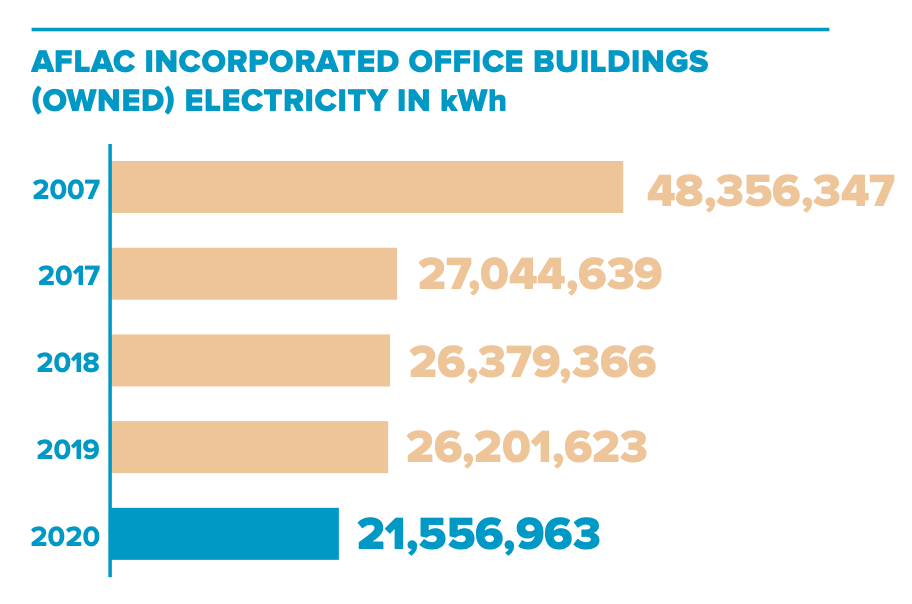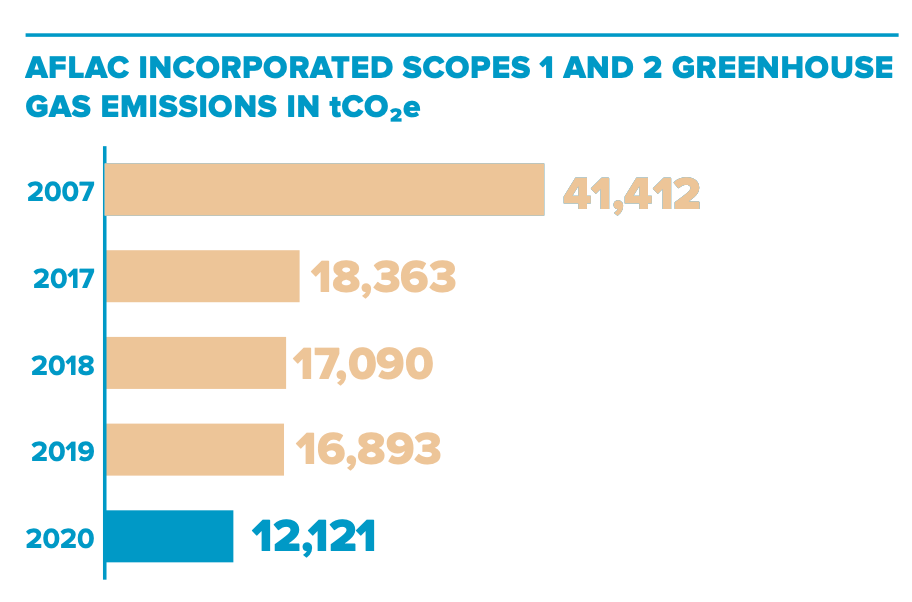SOURCE: Aflac Incorporated
DESCRIPTION:
Aflac Incorporated’s leadership in corporate responsibility is centered around limiting the company’s carbon footprint and helping make its communities, cities and planet more sustainable. This is built on the belief that environmentally and socially responsible business actions serve to enhance corporate reputation, improve talent recruitment and retention and attract new business.
Aflac SmartGreen®
The Board’s Corporate Social Responsibility and Sustainability Committee leads the company's environmental initiatives according to the Aflac SmartGreen® philosophy to wisely choose, use and dispose of the resources used each day and to focus these actions in five categories:
- Business operations.
- Waste management.
- Strategic sourcing and procurement.
- Employee engagement.
- Facilities management.

Guided by the SmartGreen Philosophy, Aflac identifies and evaluates environmental risks, including climate change, based on financial impact and probability. Risk profiles are monitored and reported every three months to its Global Risk Committee (GRC) and its interdepartmental executives.
Aflac Japan
Under its 2019 Environmental Management Declaration formalized in 2019, Aflac Japan committed to:
- Environmentally friendly behaviors in its business.
- Compliance with applicable laws and regulations related to the environment.
- Promotion of environmental education and social contributions.
- Ongoing promotion of improvements to the environment.
Climate Risk Management
In 2020, Aflac achieved carbon neutrality in its Scopes 1 and 2 greenhouse gas emissions by reducing emissions and purchasing renewable energy credits and carbon offsets. In addition, Aflac set the following climate goals:
- Reduce absolute Scope 1 and 2 emissions 75% by 2030 from a 2007 baseline.
- Carbon neutrality in all Scopes by 2040 and net zero emissions by 2050.
Aflac Incorporated reduced combined Scope 1 and 2 greenhouse gas emissions by more than 70% from 2007 to 2020.


To learn more about Aflac Incorporated’s Climate Change 2021 submission to CDP and 2020 TCFD report, click here.
Energy Conservation/Efficiency and Green Buildings
In 2020, Aflac U.S. reduced its total electricity consumption in owned corporate real estate by 21% through conservation and efficiency initiatives. Since 2007, conservation and efficiency efforts have reduced building electricity use by over 50% per square foot, saving more than $20 million.
Aflac U.S. has a decade-plus legacy of reducing electricity consumption in its owned real estate, making it the first insurance company in the U.S. to achieve ISO 50001:2011 Energy Management Systems certification and the only insurance company to achieve both ISO 50001:2011 Energy Management Systems and ISO 14001:2015 Environmental Management certifications. Aflac re-certified under ISO 50001:2011 in 2019 with zero nonconformance issues.
Aflac U.S. has reduced combined Scope 1 & 2 emissions by 33% in 2020 compared to 2019 and 74% compared to 2007 by taking steps to reduce environmental impact, such as the installation of a solar array, implementing more energy efficient HVAC and lighting systems, as well as the ISO:50001 Energy Management System based on continual improvement.
Aflac Japan reduced emissions by 2.5% in 2020 compared to 2019 and 44.4% compared to 2007 by taking steps to reduce environmental impact, such as setting air conditioning at appropriate temperatures and encouraging the use of stairs when moving floors.
Aflac has a commitment to owning or leasing green buildings whenever feasible with one Leadership in Energy and Environmental Design (LEED) Gold-certified building in the U.S. and one in Japan. In 2017, Aflac installed 500 solar panels on one of its Columbus, Georgia, buildings, and its data center was the 10th of its kind in the U.S. to become Energy STAR®-certified in 2011.
Download the 2021 Aflac Business & Sustainability Report here
KEYWORDS: Aflac, NYSE: AFL, Aflac 2021 Business & Sustainability Report, esg, csr, carbon footprint, environmental management, climate risk management, Energy Conseration, green buildings



![]()





